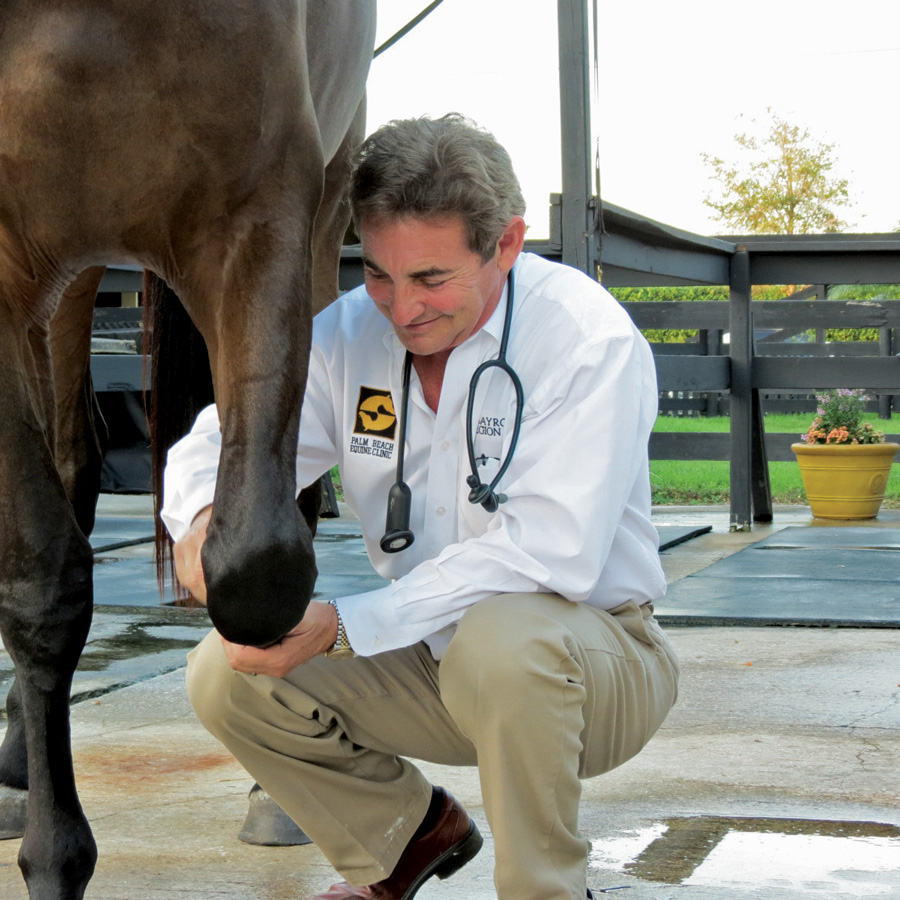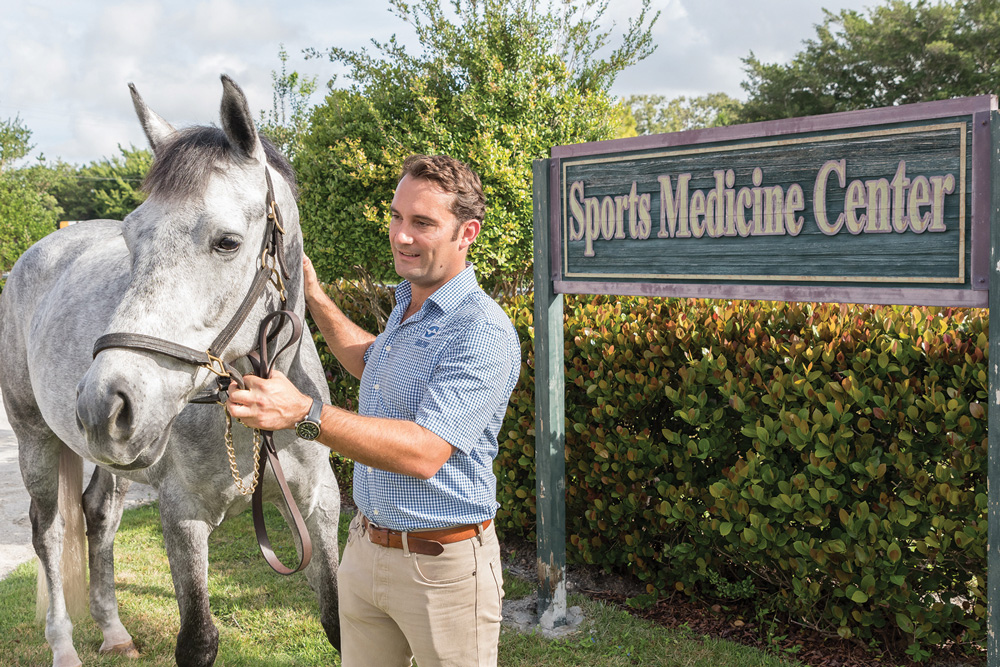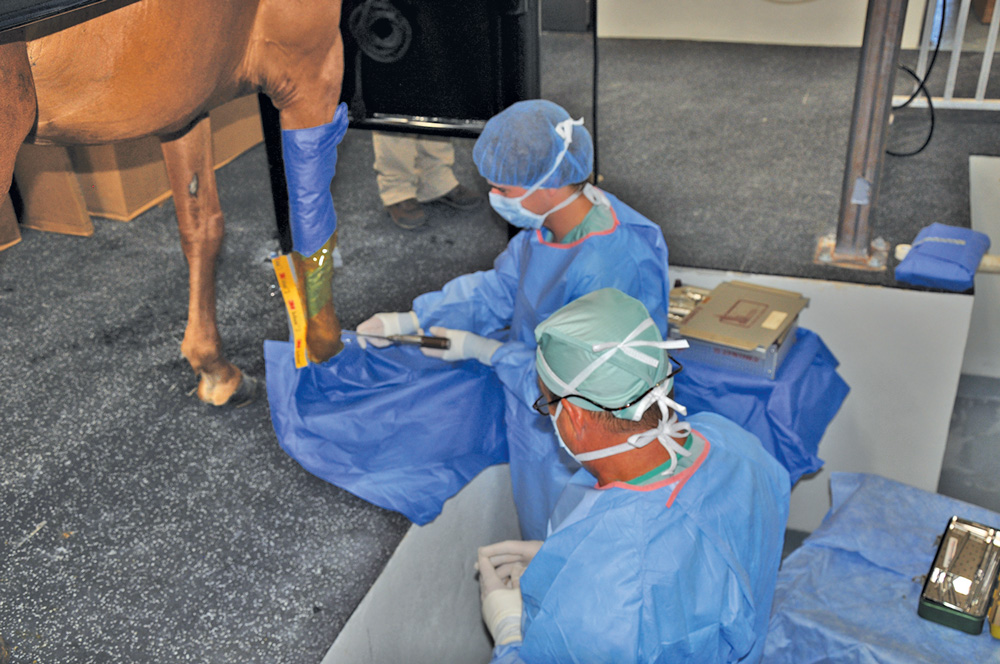Palm Beach Equine Clinic (PBEC) veterinarians start their mornings early, and their days are long as they change the landscape of veterinary medicine. PBEC recently unveiled the new face of its Wellington, Florida, facility following a year of improvements. The result? One of the most distinguished equine clinics operating in the heart of the winter horse capital of the world.
As the caliber of horses and riders calling Wellington home has risen exponentially in recent years, so too has PBEC’s ability to provide inspired care to all horses, from backyard trail mounts to Olympic champions. Founded by Dr. Paul Wollenman in 1981, PBEC was a one-man show until Dr. Scott Swerdlin joined forces with Wollenman two years later.

“From only the two of us, the clinic has grown to over 80 employees, including 40 veterinarians (including six boarded specialists), making it one of the largest sport-horse practices in the world,” said Swerdlin, a South Florida native who graduated from the University of Miami before attending veterinary school at Auburn University. “When I was graduating from vet school, I never imagined I would be leading a facility with a group of people with the skills like those at PBEC today. It’s a dream come true.
“Our industry improves each and every year. Whether it is diagnostics, treatment regimes, results, or alternative therapies, they have all made huge advances in the last 10 years,” continued Swerdlin, who set a goal nearly two years ago to be one of the first equine clinics to add a computed tomography (CT) machine to the arsenal of advanced imaging equipment at PBEC. “I would say the work that has been done with CT scans is among the newest and most exciting advances that we have experienced lately.”
With the debut of its new CT machine, PBEC veterinarians have a whole new way to diagnose lameness, solve problems of decreased performance in the sport horse, and more. More specifically, the technology has allowed PBEC to delve into a relatively unexplored part of equine anatomy: the neck. Essentially a mystery before the use of CT scans, the equine neck is now something that can be intricately examined while the horse is in a standing position.

“You can think of the spinal cord and the nerves in the neck like an interstate, with the spinal cord itself acting as the major highway,” explained PBEC veterinarian Dr. Richard Wheeler, who specializes in the treatment of sport horses. “As you are ‘driving’ along the interstate, every so often there are exits, which is where the other nerves come out. Should there be impingement on the nerves coming off of the spinal cord, it will likely present itself like an accident on the ramp of an exit, not affecting the interstate itself, but possibly causing problems that spread elsewhere. That is where we see lameness issues arise.
“Our CT machine takes 3-D images of a horse’s neck and gives us the ability to see things we would not be able to detect otherwise,” continued Dr. Wheeler, a graduate of the Royal Veterinary College in London, England. “It is a really unique technology that we are very excited to incorporate into our pre-purchase exams.”
While PBEC is well-known for its advanced imaging capabilities that also include nuclear scintigraphy and a standing MRI, the clinic also boasts a renowned group of talented surgeons. The most extensive recent improvement at PBEC included an overhaul of its surgical suite, giving the three boarded surgeons, Dr. Robert Brusie, Dr. Weston Davis, and Dr. Jorge Gomez, a state-of-the-art workspace to show off their skills. The surgery pit has made surgical procedures more comfortable for veterinarians, owners, and, ultimately, the horses themselves. Recessed to a depth of 4 ½ feet, the pit allows surgeons to perform procedures on a horse’s hock or anything below it from a standing position. Since the horses are standing, they can forgo general anesthesia in favor of a mild sedative and local nerve blocks, which has drastically improved outcomes.

One type of sport horse that has directly benefited from the PBEC surgery pit is the Thoroughbred race horse, which commonly experience repetitive strain injuries such as a condylar fracture, which is a fracture to the cannon bone. Once a career-ending diagnosis, condylar fracture repairs are now returning Thoroughbreds to the track and show jumpers to the competition ring.
“Doing these procedures while the horse is standing and not under general anesthesia takes away a lot of the risk, and it also means a faster surgery from the time the horse comes in to the time it recovers,” said Gomez, who hails from Colombia and graduated from the University of Caldas. “Amazingly, horses tolerate it really well, and it is very convenient for us as surgeons. Condylar fractures can spiral all the way up through the cannon bone, and they have a tendency to develop complete catastrophic fractures. That risk can be significantly increased by the recovery from general anesthesia. Our goal is always to have the best result for the horse, trainers, and us as veterinarians.”

PBEC also made significant improvement to its on-site reproductive center and welcomed Dr. Katie Atwood as a resident reproductive specialist. As a result of new talent and top-of-the-line equipment, PBEC is helping to revolutionize how polo ponies are bred by sending frozen embryos from polo horses in work in the U.S. to Argentina, where they are fertilized by some of the best polo stallions in the world.
“In the past, owners were forced to send their horses back to Argentina at 12 or 13 years of age to breed, but thanks to veterinary science improving their health and longevity, these horses are now on the polo field until they are 17 or 18, and that is not the best reproductive age,” said Swerdlin, himself a polo player who keeps a special place in his heart for polo ponies having grown up with a father who played as well. “We are now breeding younger horses still in training in the U.S. with stallions in Argentina, implanting the embryos into recipient mares in Argentina, and having healthy, talented foals as a result.”
When the concentration of horses is as high as it is in Wellington, especially during the winter months, biosecurity threats are always a concern. To that end, PBEC has dedicated itself to curbing the spread of disease. Following an outbreak of equine herpes in Wellington four years ago, the PBEC team immediately began planning for the addition of an isolation facility. Now complete, that facility features individual isolation stalls with separate air and cleaning systems for each horse, all under the care of internal medicine specialist, Dr. Peter Heidmann, who is a Diplomate of the American College of Veterinary Internal Medicine.
“We are establishing new goals every month,” said Swerdlin. He credits progress in equine veterinary studies for aiding in human health advances, noting, “As veterinarians, we provide solutions and services to maintain the health and safety of horses first and foremost. Today, we are seeing 16- and 17-year-old horses winning at competition, and a lot of that has to do with innovations in veterinary science. After those innovations are successful with horses, others bring the technology and ideas for human treatment. We are the testing ground for human innovations, and the future is a bright and exciting one for both industries.”
More information.
